We’ll be previewing the top 12 men’s and women’s programs for the 2019-2020 season – stay tuned to our College Swimming Previews channel to catch all 24. Can’t get enough college swimming news? Check out the College Preview issue of SwimSwam Magazine for more in-depth college swimming coverage, including a bird’s-eye view of the flood of coaching changes and our ever-popular rankings of the top 50 individual swimmers in college swimming.
#10 USC Trojans
Key Losses: Maddie Wright (13 NCAA points), Kirsten Vose (4 NCAA points), Riley Scott (1 NCAA relay), Caitlin Tycz (transfer, 1 NCAA relay)
Key Additions: Nicole Pavlopoulou (Greece – breast/IM), Aela Janvier (Canada – back/IM), Maile Lawson (HI – breast)
GRADING CRITERIA
We’re unveiling a new, more data-based grading criteria in this year’s series. Our grades this year are based on ‘projected returning points’, a stat of our own making. We started with our already-compiled “no senior returning points” (see here and here), which is effectively a rescoring of 2019 NCAAs with seniors removed and underclassmen moved up to fill those gaps. In addition, we manually filtered out points from known redshirts and swimmers turning pro early, while manually adjusting points for outgoing and incoming transfers and adding in projected points for incoming freshmen with NCAA scoring times, as well as athletes returning from injury or redshirts who are very likely NCAA scorers.
Since we only profile the top 12 teams in this format, our grades are designed with that range in mind. In the grand scheme of college swimming and compared to all other college programs, top 12 NCAA programs would pretty much all grade well across the board. But in the interest of making these previews informative, our grading scale is tough – designed to show the tiers between the good stroke groups, the great ones, and the 2015 Texas men’s fly group types.
- 5 star (★★★★★) – a rare, elite NCAA group projected to score 25+ points per event
- 4 star (★★★★) – a very, very good NCAA group projected to score 15-24 points per event
- 3 star (★★★) – a good NCAA group projected to score 5-14 points per event
- 2 star (★★) – a solid NCAA group projected to score 1-4 points per event
- 1 star (★) – an NCAA group that is projected to score no points per event, though that doesn’t mean it’s without potential scorers – they’ll just need to leapfrog some swimmers ahead of them to do it
We’ll grade each event discipline: sprint free (which we define to include all the relay-distance freestyle events, so 50, 100 and 200), distance free, IM, breaststroke, backstroke, butterfly and diving. Bear in mind that our grades and painstaking scoring formula attempts to take into account all factors, but is still unable to perfectly predict the future. Use these grades as a jumping-off point for discussion, rather than a reason to be angry.
2018-2019 LOOKBACK
USC was led, as it has the past few years, by Swedish star Louise Hansson. The do-everything talent completed her transition into a two-distance butterflyer, winning NCAA titles in both the 100 and 200 flys. Hansson was outstanding, going 49.26 in the 100 and 1:50.28 in the 200 while also taking 4th in the 200 IM (1:52.14).
Outside of that, though, things were a little thin. Seniors Maddie Wright (13 points) and Kirsten Vose (4 points) scored individually and junior diver Carly Souza chipped in a point. But the bulk of the scoring came in relays, where USC was 9th or better in all relays, besides a big finals DQ in the 200 medley.
The Trojans ended up 10th overall – a slight improvement from a relatively disappointing 12th-place showing in 2018, but otherwise USC’s lowest finish since 2008.
Sprint Free: ★★
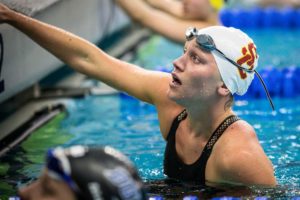
Marta Ciesla (photo: Jack Spitser)
Marta Ciesla was a big-name recruit a couple years ago, and though she didn’t have big returns as a freshman, she’s come into her own through the middle of her NCAA career. Ciesla went 21.8 and 47.8 last year, putting her among the nation’s better sprint freestylers. The ongoing downside is that both of those times came at midseason, and Ciesla was pretty significantly slower at Pac-12s (21.9/48.2) and NCAAs (22.1/49.5). Ciesla is going to need her best swims to come at nationals to buoy this team the way a sprinter of her caliber can.
Australia’s Laticia Transom was another big contributor last year, and has better range across all three events in this discipline. Transom was 22.2, 48.1 and 1:44.2, though like Ciesla, all three of those times came from Pac-12s and Transom didn’t score at NCAAs.
Those two will need to score individually to keep USC in the top 10, but they have the ability to make the Trojan relays dominant.
Further back, senior Tatum Wade (1:44.2/48.6) could be a scorer in the 200 at least, and another Australian, Jemma Schlicht, is on the cusp of NCAA scoring at a couple distances (22.4/48.5/1:45.4). Courtney Caldwell has been medically disqualified – she had the ability to make this group one of the NCAA’s best, but was also a longshot while struggling with injuries in her one season with the Trojans.
Distance Free: ★
The distance corps is absolutely barren for USC, though, even though it’s not for lack of trying in the recruiting realm. USC hauled in two elite distance recruits in recent years (Becca Mann and Erica Sullivan) only to see Mann turn pro last summer and Sullivan defer her freshman season until after the Olympic year.
Without those reinforcements, USC’s top five 500 times from last year graduate, and even most of them were transplants from other events. Elizabeth Stinson (16:15) and Allie Wooden (16:30) were the team’s top two milers, and they both graduate. That means that without a distance freshman coming in (that we know of, at least), the team will only return one single swimmer who logged a 500 or 1650 free at any point last season: junior Isabella Rongione. Rongione was a pretty big name coming out of high school, but her best times (4:43/16:07) are coming up on five years old and she’s mostly gone backwards in two collegiate seasons.
Backstroke: ★
Hansson was able to cover over the team’s backstroke weakness last year, taking on the leadoff leg of the 400 medley. She might be in that same position again this year, because the backstrokes are relatively thin.
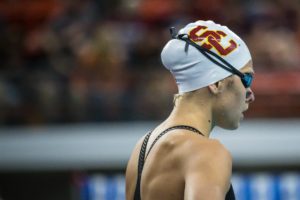
Hanni Leach (photo: Jack Spitser)
Hanni Leach should return for her redshirt senior year. She was listed in NCAA results as a senior, but on USC’s roster as a redshirt junior, and should have one year of eligibility remaining. Leach was 53.6 last year, but was 52.00 back in 2017, before knee surgery costed her what would have been her junior season. She was also 1:52.5 pre-injury, but was just 1:57.3 last year. Needless to say, Leach’s continued return to form is the major driver of this backstroke group.
Canadian import Aela Janvier is a good depth prospect for the future. Her long course times (1:03.1/2:11.8) roughly convert to 54.2 and 1:54.3, so she’s probably not an immediate NCAA scorer, but could develop enough to take over for Leach after this year.
Breaststroke: ★
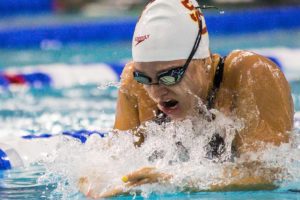
Maggie Aroesty (photo: Jack Spitser)
The breaststroke group was hit hard by graduation. Both sub-minute options (Riley Scott and Kirsten Vose) are gone in the 100. They were also 2:07 and 2:08 in the 200.
It’s time for elite prospect Maggie Aroesty to step up in her junior season. 58.9/2:09.4 out of high school, Aroesty improved her 200 tremendously as a freshman (2:06.8), but saw her 100 go backwards half a second. Last year was tough all-around, with regression back to 1:00.3/2:08.9 and no NCAA points. Aroesty has the potential to score big, but needs a big turnaround.
Isabelle Odgers (1:01.3/2:10.5) had a pretty good freshman year, but is a ways from NCAA scoring level (59.5/2:08.7). A couple of incoming freshmen could project as scorers down the road: Greece’s Nicole Pavlopoulou is 1:10/2:28 in long course (roughly converted to 1:01.6/2:10.1), and Hawaii’s Maile Lawson is 1:01.3/2:13.8.
Butterfly: ★★★★
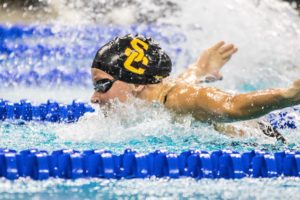
Louise Hansson (photo: Jack Spitser)
OK, it’s been tough sledding for USC so far. So why do we still have them at #10? Butterfly is why.
It’s not just Louise Hansson, who by herself would probably be a four-star class. Seriously, 49.2 and 1:50.2 are outstanding times, and Hansson has consistently gotten faster every year at USC. She’s no guarantee to win both butterflys with a red-hot Maggie MacNeil in the mix along with Erika Brown and Grace Oglesby. But Hansson is as good a bet as there is to score major, major points in the butterflys.
Despite graduating Maddie Wright and losing 1:54 flyer Caitlyn Tycz to transfer, this group is still great. Catherine Sanchez was 18th at NCAAs in the 200 last year and is projected to move up into the B final. Meanwhile Jemma Schlicht was 52.1 in the 100 last year and should move up into scoring range.
IM: ★★★
If Hansson swims the 200 IM this year (she could also do five relays, or the 50 free, or backstroke, or… literally anything), this is a great event for USC, much like butterfly. Hansson was 4th in the 200 IM at NCAAs last year and two of the three ahead of her graduate.
Wade is another one who will probably cross over from the freestyles. She was 1:55.63 last year, and with seniors factored out, she moves within ten spots of scoring.
The 400 might be a bit more of a stretch, with top swimmer Riley Scott graduated. The closest to her 4:12 last year was 4:15 Isabelle Odgers.
A couple freshmen could also cross over into the IMs. Pavlopoulou’s long course best (2:16.2) converts to roughly 1:58.6, and Janvier’s 2:17.4/4:51.9 long course times roughly convert to 1:59.5 and 4:16.1. Probably not instant scorers, but prospects with potential.
Diving: ★★
USC had two scoring divers last year. Carly Souza was 16th on platform, and a slew of graduations move her up to 9th among returners. Meanwhile Naomi Gowlett was a three-event NCAA qualifier, and factoring out seniors puts her in line to score on both 1-meter and platform.
Relays
Hansson is such a weapon for the relays. She led off the 800 free relay last year in 1:41.9, and three-quarter of that third-place relay return. Vose’s 1:43.5 split will be tough to replace, but 1:45.4 Schlicht can hold her own. With Transom (1:43.6 last year) and Wade (1:43.0) still in the mix, the Trojans are one of the best relays nationally here.
The sprint relays are in pretty good shape, too. All four legs of the 200 free relay return (Ciesla, Wade, Schlicht, Transom) after going straight 21s last year. And the entire 400 free relay (Hansson, Wade, Schlicht, Transom) are back. The story on both of those relays is getting the job done in prelims – both ended up 9th at NCAAs, going pretty significantly faster in finals than they did in prelims. They’re legitimate A final relays if they can be near their best on the morning of NCAAs.
The medleys are in a little tougher shape. With Vose and Scott gone, it’ll take a big rebound from Aroesty or a great freshman year from Pavlopoulou to have a breaststroker who can stay with the NCAA scoring field. The question will be whether USC goes with Hansson on back and Schlicht on fly or Leach on back and Hansson on fly. Either way, Hansson’s leg is probably elite, and the other leg just OK. The anchor should be fine, whether it’s Transom or Ciesla. Pencil in both medleys as probable B final teams with low-A final upside.
2019-2020 Outlook
With Hansson still firmly in the mix, USC should remain one of the nation’s better programs. They’ve got their weaknesses (distance free, backstroke, breaststroke), but have plenty of power packed into their strengths (fly, IM, sprint depth) to make up the points elsewhere.
What really buoys USC are their relays – you can score a lot of points in the NCAA by having good relays, even if the majority of your members aren’t individual scorers. But to push into the top 10, the Trojans need to maximize those relay points: between the trio of 9th-place finishes and a DQ of the 200 medley relay, USC left about 30 relay points on the table. That alone would have moved them from 10th to 6th.
The other theme has to be showing up at NCAAs. USC has had too many swimmers lately putting up best times at mid-season and not just failing to repeat them at NCAAs but falling off significantly. That said, the upside of the Trojans is pretty significant – improvements in those two areas could have them vying for a top-5, rather than top-10, spot.
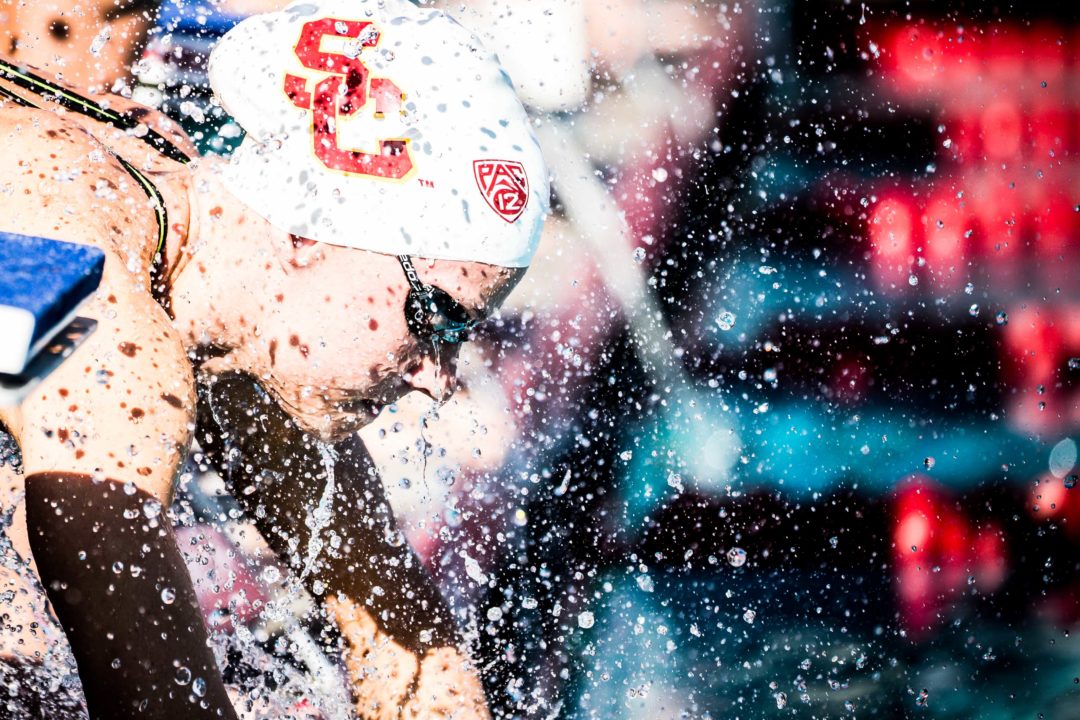
Kirsten Vose is a red-shirt senior this year. She missed most of her true 2018 junior season due to injury and received a medical redshirt. At last year’s NCAAs she anchored USCs 800 free relay in 1:43.57, clocked a 59.13 on the breaststroke leg of the 400 medley relay and posted her second career scoring swim in the 200y breast, finishing fifth in the B final in 2:08.87 after a season-best 2:08.51 in prelims. If Kirsten can completely return to her pre-injury form she could score in the 200 !M, the 100 breast, the 200 breast and be a member of both free relay and medley relay teams.